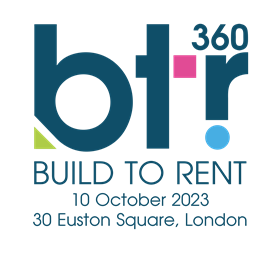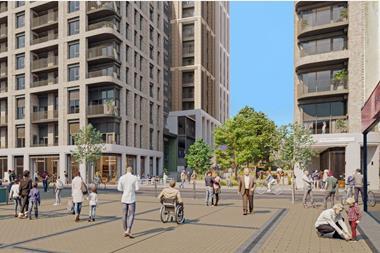This may be the first time that the microbiome and build to rent (BTR)/co-living have appeared in the same sentence, which is very disappointing as the microbiome is key to individuals’ health and the buildings they live in.

BTR and co-living operators take up a lot of time and website space talking about the importance of wellness and this comes in two forms: physical and mental wellness, the gym and yoga, perhaps with some green space and ponds nearby to encourage wildlife.
The microbiome is one aspect of wellness that operators ignore, if not actively discourage, and it is more important than the other two forms.
The microbiome: a new dimension for BTR
Our microbiomes, the microbial worlds living within us and our homes, are crucial to health. Microbiome science is game-changing for the wellness industry: it underpins a personal care and hygiene sector worth more than £10bn in the UK alone.
How ‘well’ building design supports ‘good’ and not ‘bad’ microbial co-livers is increasingly important.
Like Russian dolls, healthy microbes need healthy host human and building ecosystems to thrive. So why is microbiome design not yet a co-living wellness service standard? We need to catch up with the science – now.
What are microbiomes and why are they vital to our health?
Microbiomes are collections of trillions of interacting micro-organisms, colonising every space in and on our bodies and homes. They play a kaleidoscope of pivotal roles for wellness, powerfully affecting our health.
Rich, diverse, good microbes are crucial to keeping us well. Reduced, less diverse, bad microbes can drive disease, including cancer. The better our microbiomes, the better our health and vice versa.
Up to 90% of urban life may be spent indoors. So, it’s no surprise that our built environment and the built environment microbiome (BEM) significantly affects the health and wealth of the human microbiome. BEM is now well recognised in architectural discussion and design.
Excess sanitisation and powerful cleansing chemicals are related to reduced, less healthy skin and microbiomes. They can also promote microbes with antimicrobial resistance, already a global threat to health. This matters – a lot.
The most frequent reason to consult a GP in the UK is related to a skin microbiome problem (dysbiosis). Allergic dermatitis is increasing at a rate of 10% a year in urban populations. We need to find out how to build and co-live in a way that promotes healthy microbiomes. This is unlikely to be solitary units with ensuite bathrooms and poor access to outdoor air and space, gardening and tepid microbe-rich freshwater bathing.
Gut dysbiosis is associated with ultra-processed food and ready meals. It doesn’t take the brain of Britain to realise that solitary units with a microwave and easier access to delivered meals than kitchen/dining facilities you have to pre-book are unlikely to promote a healthy gut microbiomes.
Gut dysbiosis can increase vulnerability to many illnesses beyond gut disease – mental health, neurological issues, obesity, diabetes, cardiovascular disease and cancer. Some cancer treatments only work well in tandem with a healthy gut microbiome: fact.
Opportunities for healthy microbiomes in buildings and co-livers: the ‘homiome’
We already know enough about education and interconnected, interdisciplinary design to start making microbiome wellness the asset it needs to be for co-livers. This might include a series of seminars and incentivised, free kitchen/dining space to cook and eat unprocessed food, ideally communally.
Operators could even provide recipe packs and invite chefs and microbiome trainers for premium unit welcome packs.
BTR/co-living operators need to recognise the importance of microbiome wellness, or the ‘homiome’, before renters turn their backs on dysbiotic building design or even start to blame ill health on poor BEM/microbiome design. The time has come for microbiome best practice to be an industry standard.
Current approach of the industry in the UK – design guides
This part is brief because the design guides and charters of both the public and private sector in the whole rental sector, not just BTR and co-living, make no reference to the microbiome. We have searched trade publications only to find that the word ‘microbiome’ or even ‘biome’ have never been used. Likewise, you can read best-practice guides from highly regarded professional bodies and find no mention of the microbiome.
This is odd as the industry is keen to stress the importance of healthy living and biodiversity, creating wildlife areas for otters and butterflies, all very visible and which contribute to tenants feeling better about their place in the world. However, if their internal biodiversity is poor, the benefit of that external biodiversity, the ponds and greenery, is limited.
Current approach of the industry – operational
This too is not helpful to maintaining a healthy microbiome: firstly, because all living units have their own bathrooms, which can encourage excessive hygiene; and secondly, because properly fitted kitchens are not common, which in turn makes it difficult to cook a meal from raw ingredients. Instead, in many places it is easier to heat up a ready meal in a microwave, a form of highly processed food that is bad for the human microbiome. By contrast cooking and eating are also well-established social activities that combat the loneliness of solitary communal living.
Thirdly, the focus on high-quality service makes it easier for a meal to be delivered, again more highly processed food with minimum social engagement. Here we have to think of the incentives for the operators: that it is easier to recycle the paper bag/cardboard box used for a delivered meal than to deal with the waste when preparing meals from raw ingredients, even though that waste can be rapidly turned into compost to nurture the green space. Perversely, the focus on service may encourage bad eating and add to the obesity crisis common to the west.
We could argue that the current approach to food common to BTR, student accommodation and co-living schemes is redolent of the dinner scene in Buñuel’s film The Phantom of Liberty; eating is done in solitude and out of necessity, very much a bodily function rather than a source of health, relaxation and sociability.
Opportunity for a reset for the industry and the individual
We accept that the trend of residential is towards hotel-style living in small units, but we believe that to create healthy living for tenants and buildings the industry must provide the infrastructure that nourishes the microbiome of the body and the building.
We believe that the individuals staying in co-living schemes need encouragement and support from the operators, who in turn have a unique opportunity to instil good habits that should keep everyone in good health for the rest of a long and active life.
The focus on wellness is welcome but can only be effective when it includes the third and most important element: the microbiome. We encourage all those involved in co-living and across the wider residential/living sector to join the dialogue on how best to meet this challenge.
What the experts say
Most of us are aware of the government’s five-a-day slogan, which started at as 10-a-day but was reduced to five to make more palatable to the public. This gives you a sense of the problem we face.
You might want to try Tim Spector and his recommendation to eat 30 types of plants a week: https://joinzoe.com/post/tim-spector-gut-tips
His contribution to the BBC Food programme: https://www.bbc.co.uk/programmes/m001fvnx
You could also try Mark Schatzker’s book The Dorito Effect, which argues that obesity is not about fat or carbs, the traditional approaches, but how highly processed food, most of all artificial sweeteners, messes with the mind’s ability to assess/monitor food intake.
Michael Pollan summarises a healthy diet as: ‘Eat food. Not too much. Mostly plants.’
Jonathan Monnickendam, principal, Development Debt Consultancy
Property Week’s inaugural BTR360 – Conference, Showcase and Awards – takes place on 10 October in London, addressing and connecting the full build-to-rent ecosystem, followed by a celebratory awards evening.
View the awards categories and start your entries today






























No comments yet